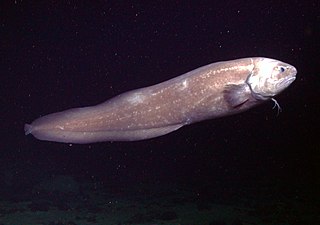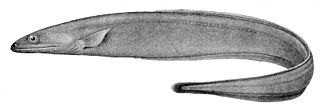
Ophichthidae is a family of fish in the order Anguilliformes, commonly known as the snake eels. The term "Ophichthidae" comes from Greek ophis ("serpent") and ichthys ("fish"). Snake eels are also burrowing eels. They are named for their physical appearance, as they have long, cylindrical, snake-like bodies. This family is found worldwide in tropical to warm temperate waters. They inhabit a wide range of habitats, from coastal shallows and even rivers, to depths below 800 m (2,600 ft). Most species are bottom dwellers, hiding in mud or sand to capture their prey of crustaceans and small fish, but some are pelagic.

The cusk-eel family, Ophidiidae, is a group of marine bony fishes in the Ophidiiformes order. The scientific name is from the Greek ophis meaning "snake", and refers to their eel-like appearance. True eels diverged from other ray-finned fish during the Jurassic, while cusk-eels are part of the Percomorpha clade, along with tuna, perch, seahorses and others.

Synaphobranchus is a genus of eels in the cutthroat eel family, Synaphobranchidae. It currently contains the following species:
Gnathophis is a genus of marine congrid eels.

Leptocephalus is a genus that was used for species of larval eels, called leptocephali. Leptocephali larvae differ so much in appearance from their adults. When first discovered, leptocephali were thought to be a distinct type of fish, not an eel specie. Because of this, the genus designation of Leptocephalus was used for a while for an unidentified leptocephali. After it was known that these were eel larvae, it was identified to be part of a wastebasket taxon, but not anymore in the present classification system. Examples of marine congrid larvae, found in the western Indian Ocean and the Red Sea that were named this way are listed below. Only two species in two families are currently treated as having any validity, though the validity of L. bellottii is strongly in doubt.

Heteroconger is a genus of marine congrid eels. These small, slender garden eels live in groups where each individual has its own burrow. Usually, only the head and front half of the body is visible. The greatest species richness is in the Indo-Pacific, but species are also found in the warmer parts of the Atlantic and the eastern Pacific. Its name relates to how a huge colony of the eels looks swaying in the current.

The Colocongridae, the worm eels or short-tail eels, are a family of eels, containing a single genus, Coloconger.
Myroconger is the only genus of eels, the thin eels, in the family Myrocongridae. Very little is known about the group.

Eels are ray-finned fish belonging to the order Anguilliformes, which consists of eight suborders, 20 families, 164 genera, and about 1000 species. Eels undergo considerable development from the early larval stage to the eventual adult stage and are usually predators.

Ariosoma is a genus of marine congrid eels.
Bathycongrus is a genus of eels in the family Congridae.

Nettastoma is a genus of eels in the duckbill eel family Nettastomatidae.

Nettenchelys is a genus of eels in the duckbill eel family Nettastomatidae.

Callechelys is a genus of eels in the snake eel family Ophichthidae. It currently contains the following fifteen species:

Quassiremus is a genus of eels in the snake eel family Ophichthidae. It currently contains the following species:
Benthenchelys cartieri is an eel in the family Ophichthidae. It was described by Henry Weed Fowler in 1934. It is a tropical, marine eel known from the Philippines, in the western central Pacific Ocean. It is known to dwell at a maximum depth of 1168 m, and inhabits the pelagic zone.
Benthenchelys indicus is an eel in the family Ophichthidae, described by Peter Henry John Castle in 1972, originally as a subspecies of Benthenchelys cartieri. It is a marine, deep-water-dwelling eel known only from its type locality in the eastern Indian Ocean. It inhabits the pelagic zone.
Benthenchelys pacificus is an eel in the family Ophichthidae, described by Peter Henry John Castle in 1972, originally as a subspecies of Benthenchelys cartieri. It is a marine, deep-water-dwelling eel known only from its type locality in the eastern central Pacific Ocean. It inhabits the pelagic zone.
The angry worm eel is an eel in the family Ophichthidae. It was described by Peter Henry John Castle and John E. McCosker in 1999. It is a tropical, marine eel which is known from the eastern Indian and western central Pacific Ocean, including India, Indonesia, the Straits of Malacca, northern Australia, and the Philippines. It is known to inhabit shallow, turbid estuaries, and to a lesser extent the deeper water over soft substrates. Males can reach a maximum total length of 29.6 centimetres.











